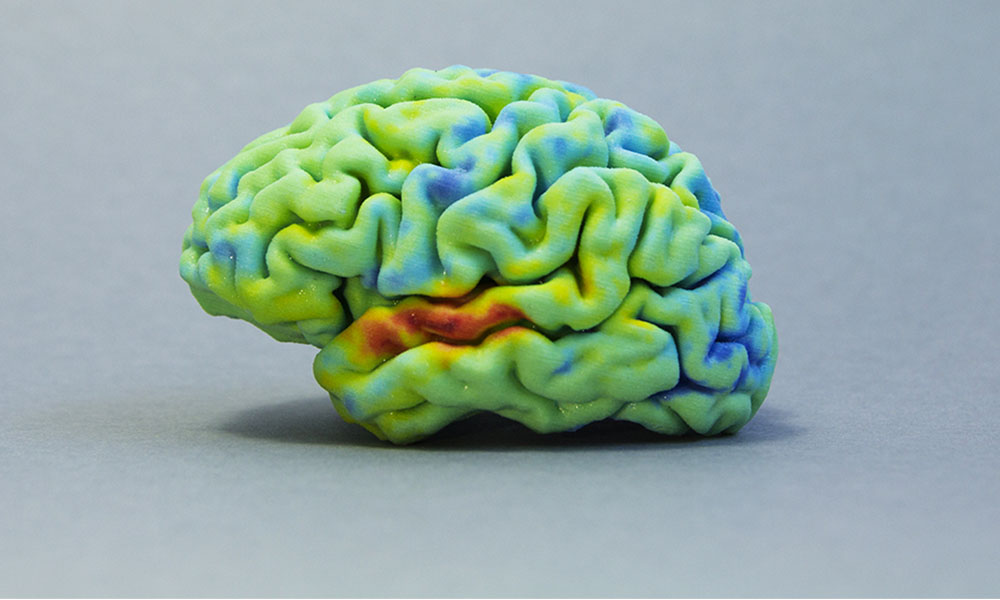Medical 3D printing: Discover the 3D printed brain
Posted By Lucie Gaget on Jun 1, 2018 | 0 comments
Medical 3D printing is offering a lot of new possibilities for research and diagnosis. By making a 3D scans and a 3D models of the organ or body part of the patient, it is actually possible to get a better visualization of the problems. Some surgeons are even 3D printing organ models to show and explain the diagnosis to their patient. It can help them to understand how they are going to be cured. Surgeons can also rehearse some difficult surgeries and anticipate some complications by training on 3D models.
With a human part as complex as the brain, how 3D printing can be useful? We are going to see all the benefits of the 3D printed brain!
3D printing human brain models: A new method developed by the MIT/Harvard team
3D printing brain models for the medical industry
3D printing is more and more used in the medical industry. More specifically, it is becoming an incredible asset for surgeons, in order to rehearse their surgeries. For example, we saw recently that it is possible to 3D print kidney models to prepare complex surgeries and save lives.
This 3D printed brain technique has been elaborated with the case of Steven Keating, a Ph. D. His brain tumor has been removed, but he was curious to see how his brain looked before and after the surgery, in order to get a better understanding of the diagnosis. He collected all his MRI scans and other medical data to 3D print them. But the medical 3D printing methods were not allowing to get really accurate results, which wasn’t really satisfying. That is why he decided to collaborate with a team of researchers to develop a new and more accurate 3D printing brain technique.
Finding new solutions
Additive manufacturing is taking more and more space in the medical industry. Kidney, jaw reconstruction, surgical tools, everything seems to be 3D printable, allowing to save time and money. And what about the brain? Manually processing MRI and CT scan data can take more than 30 hours. But thanks to the new pixel-by-pixel approach developed by the MIT/Harvard team, this process could take less than one hour! Moreover, this technique allows to print models with an impressive level of details.
Credit: James Weaver and Steven Keating/Wyss Institute at Harvard University
How does this method work?
The goal is to convert images in a series of bitmap layers, it is working like the “slices” that makes the object 3D printable. This method relies on printing with dithered bitmaps, a file format where all the pixels of a grayscale image are converted into black and white pixels.
The density of these pixels defines the shades of grey, rather than the pixels themselves varying in color. It is quite similar to black and white newsprint that everybody knows, varying the size of black dots to create accurate pictures.
What are the advantages of this new method?
It is actually allowing to get more detailed models, to save time and money. This method is providing the most accurate medical 3D printed models, as 3D printed human brains models. It is also making the process more convenient and easier, helping to convert really complex images into a 3D printable format, and allowing to make an accurate 3D printed medical object. Indeed, the format found to print the 3D model actually conserve all the details present in the MRI scan.
https://3dprintingindustry.com/news/thanks-mit-harvard-brains-can-now-3d-printed-pixel-133954/
3D print your own brain thanks to our tutorial!
We already gave you some tips on the blog to help you to get a 3D printed replica of you own brain. You can still check our tutorial and 3D print your own brain using this tutorial! Get your first 3D printed brain experience! If you are working in the medical sector, you will quickly see how helpful this technology could be in your daily work.
First, to 3D print your brain, you have to get your brain scanned. Once you will have your brain MRI, you will have to download the right 3D software. The little difficulty here is to convert the scan in a 3D model that will be perfectly 3D printable: converting the CT scan – hopefully, there are software allowing you to do this. You will have to download Freesurfer to convert your scan into a printable model and 3D print your brain.
Thanks to the evolution of 3D bioprinting it will soon be possible to 3D print brain tissue and full human organs! Indeed, check our blog post to see what it is actually possible to do today with 3D bioprinters. These amazing 3D printers will be real lifesavers to print human tissues in the future.
Do you have the 3D model of your brain ready for 3D printing? Upload your 3D file right now on our online 3D printing service! The future of medical 3D printing is really promising and will surely help to save millions of lives. If you want more information and more blog posts to read about these impressive 3D printing applications, feel free to subscribe to our weekly newsletter.
Photo credit: https://www.pbs.org/newshour/science/3-brain-technologies-to-watch-in-2018


 Connect with Google
Connect with Google Connect with Facebook
Connect with Facebook

